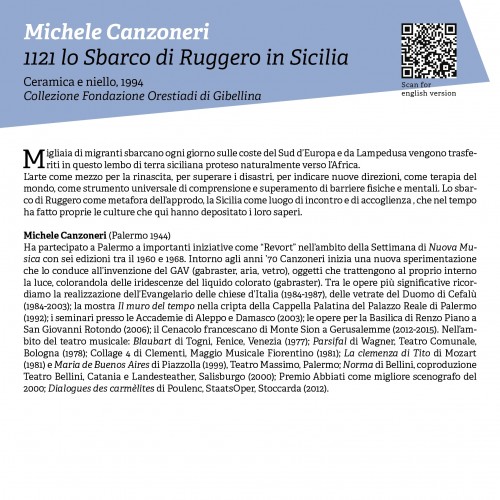1121: Ruggero's Arrival in Sicily
Ceramic and niello, 1994
Collection of the Orestiadi Foundation of Gibellina
Thousands of migrantsarriveeach day on the coasts of southern Europe and from Lampedusa theygettransferred in this plot of sicilianlandnaturallyextended towards Africa.
Art as the medium for rebirth, to overcomehardships, to point towards new directions, as a therapy for the world, as an universal tool thatallowsus to understandeachother and overcomephysical and mentalbarriers. Ruggero's landing as a metaphore for arrival, Sicilyas a place of meeting and hospitality, which made itsown the culturesthatbroughtheretheir knowledge.
Michele Canzonieri (Palermo, 1944)
In Palermo, he took part in important events like "Revort" in the scope of the week of Nuova Musica with sixeditionsbetween 1960 and 1968. In the 70's Canzonieri starts experimenting, and the resultis the invention of GAW (Gabraster, Air, Wind), objectsthathold light in themselves, coloringit with the iridescence of the coloredliquid. Amonghismostnoteworthy works thereis the creation of the Evangelarium of Italy'schurches (1984-1987), of the stained glass in the Cefalù's Duomo (1984-2003); the exhibit "The Wall of Time" in the crypt of the Palatine Chapel of the Royal Palace of Palermo (1992); the seminarsat the Aleppo and Damascusacademies (2003); his works for the Renzo Piano Basilica in San Giovanni Rotondo (2006); the francescancenacle of Mount Sion in Gerusalem (2012-2015). In the field of musical theatre: Blaubart by Togni, Fenice, Venice (1977); Parsifal by Wagner, Communal Theatre, Bologna (1978); Collage 4 by Clementi, Musical May of Florence (1981); The Clemency of Titus by Mozart (1981) and Maria de Buenos Aires by Piazzolla (1999), Massimo Theatre, Palermo, Norma by Bellini, co-production Bellini Theatre, Catania and Landesteather, Salzburg (2000); Abbiati Award for best set designer in 2000, Dialoguesdescarmèlites by Poulenc, StaatsOper, Stuttgart (2012).
